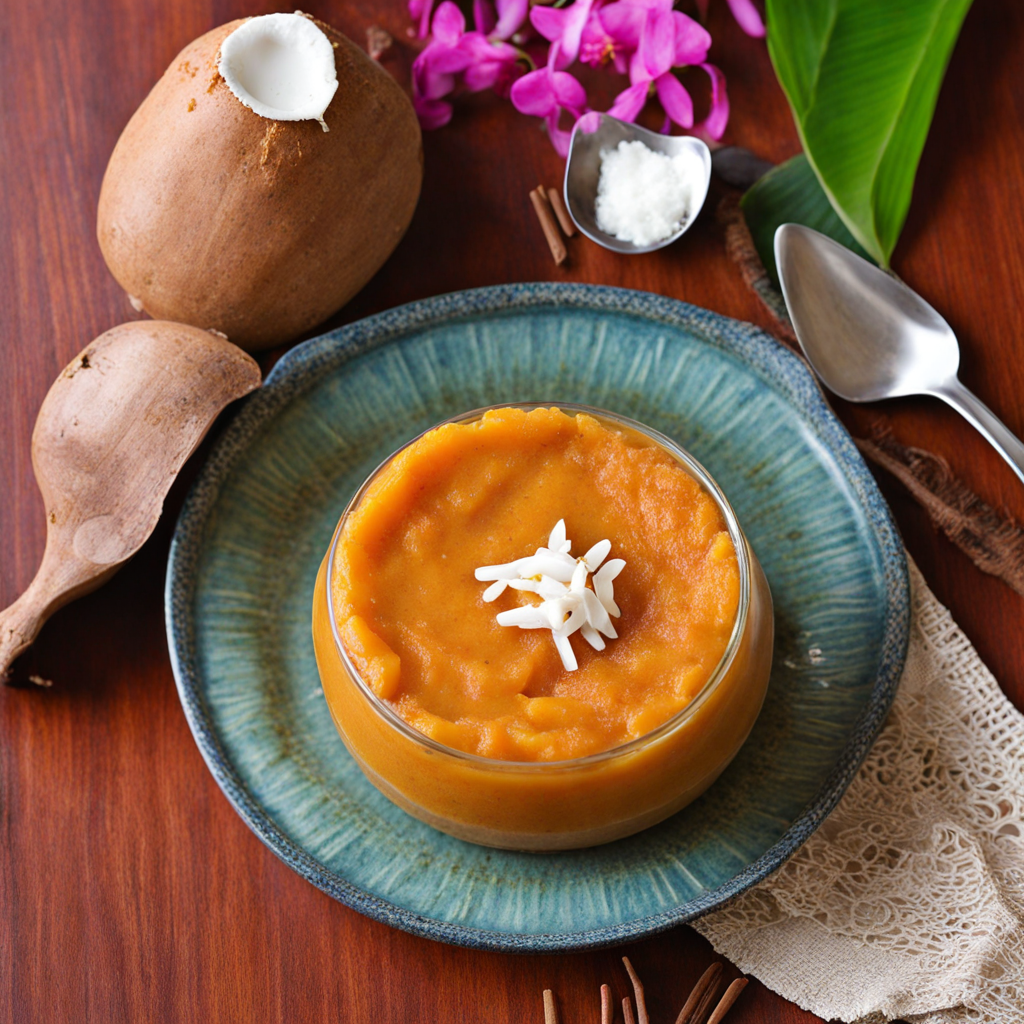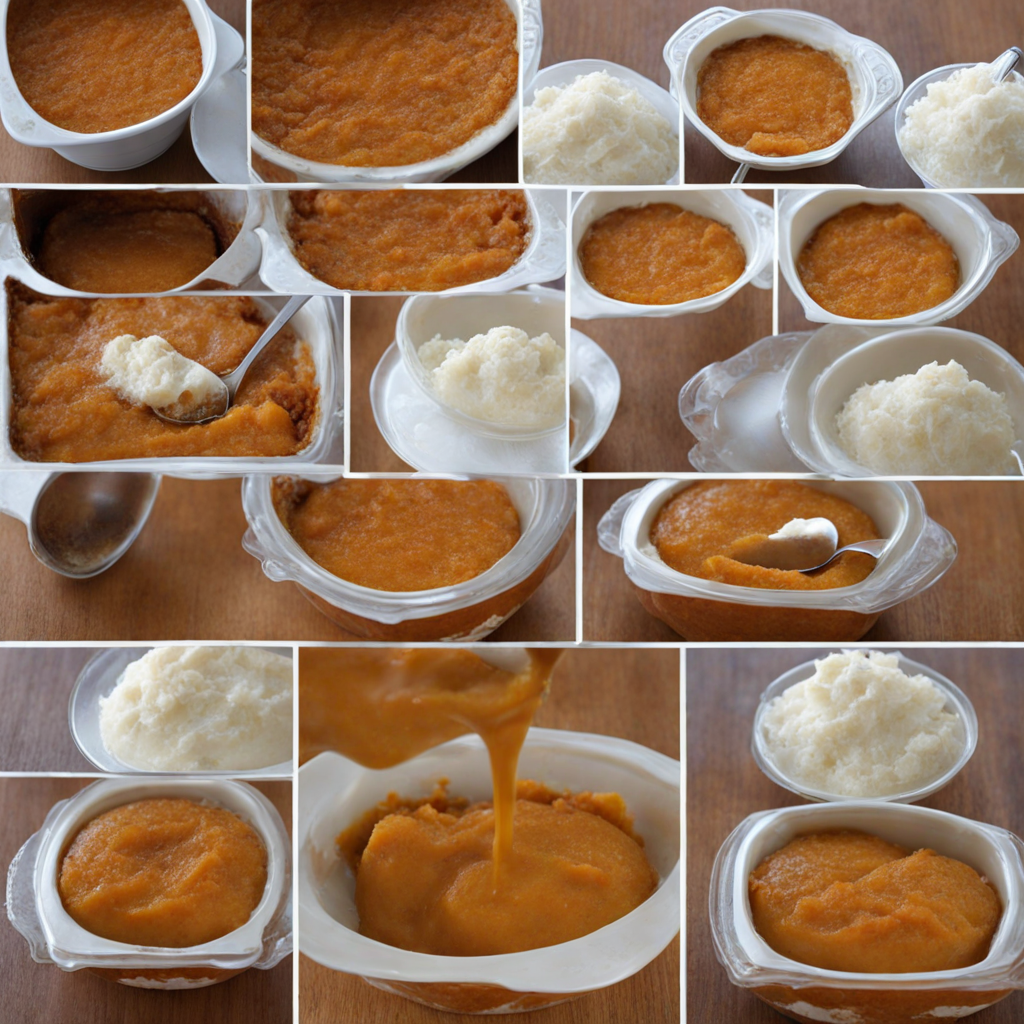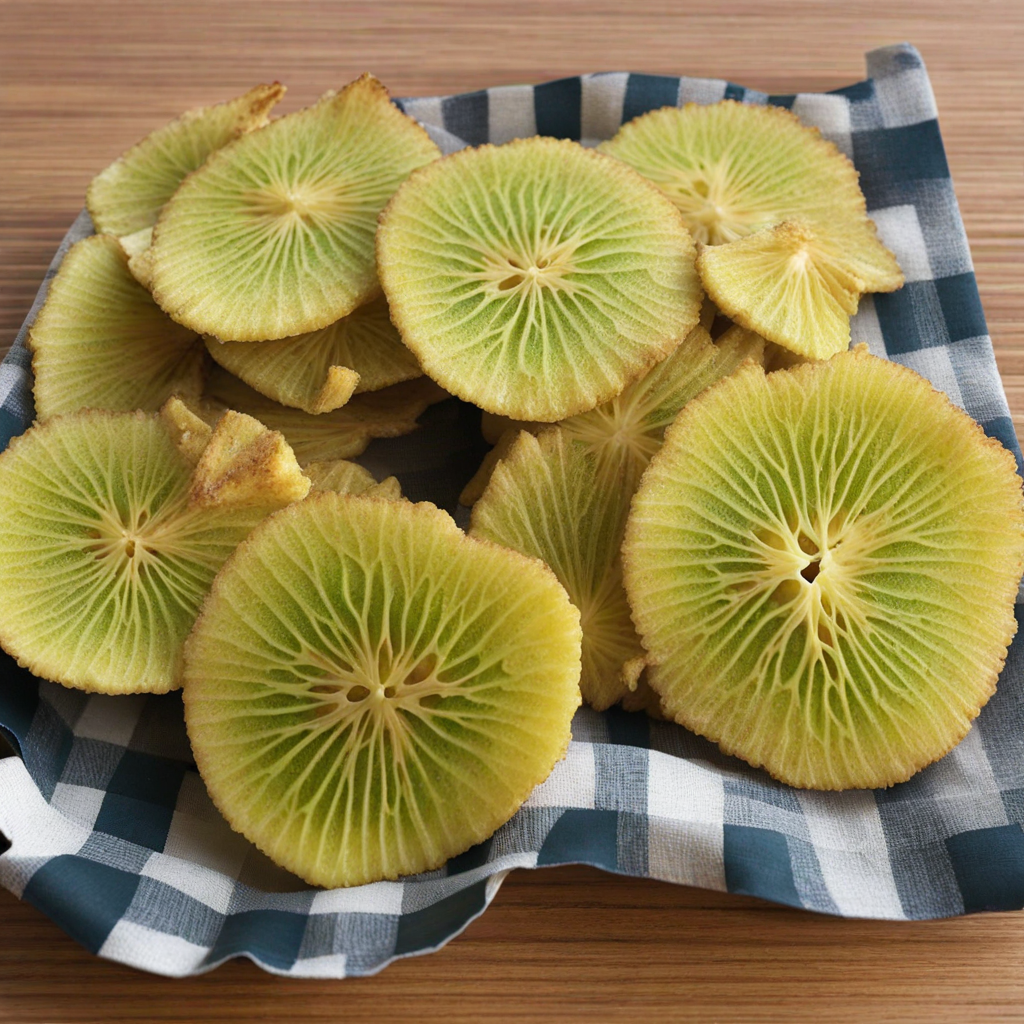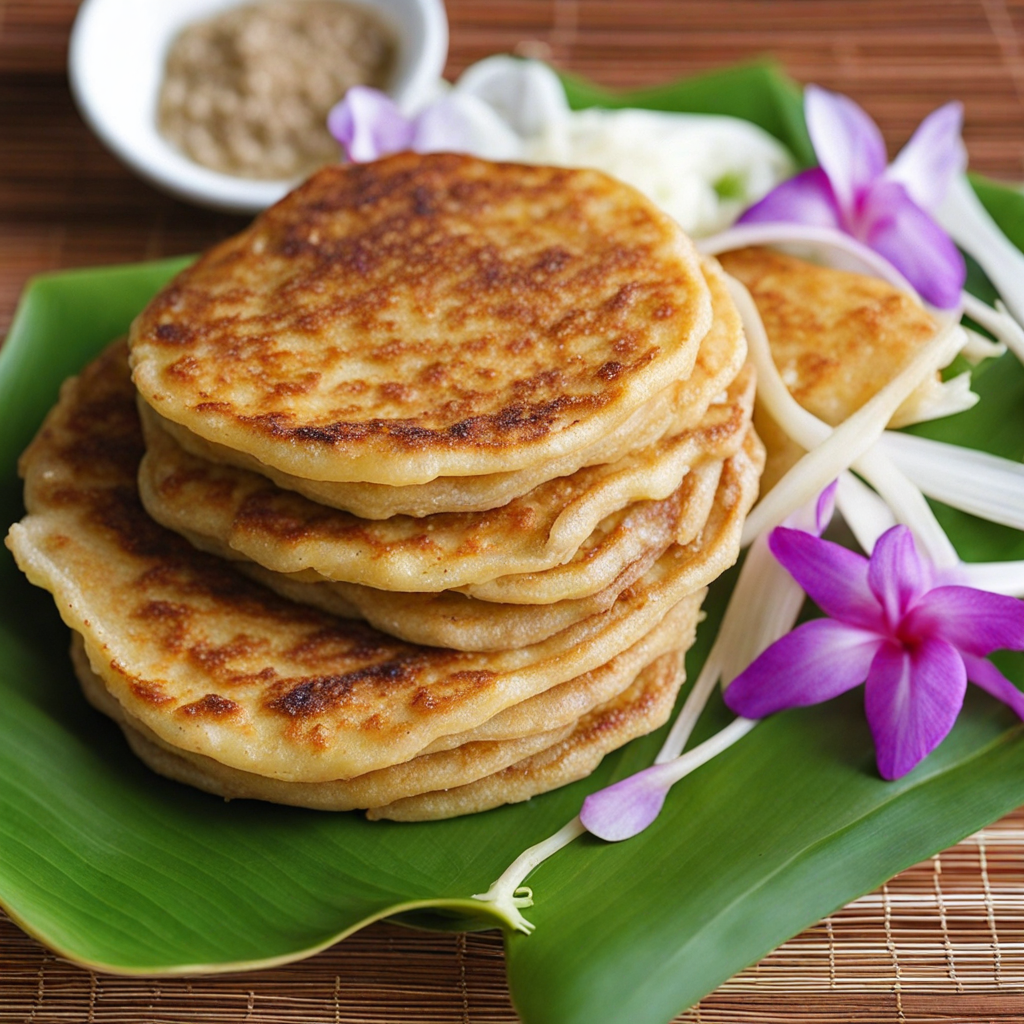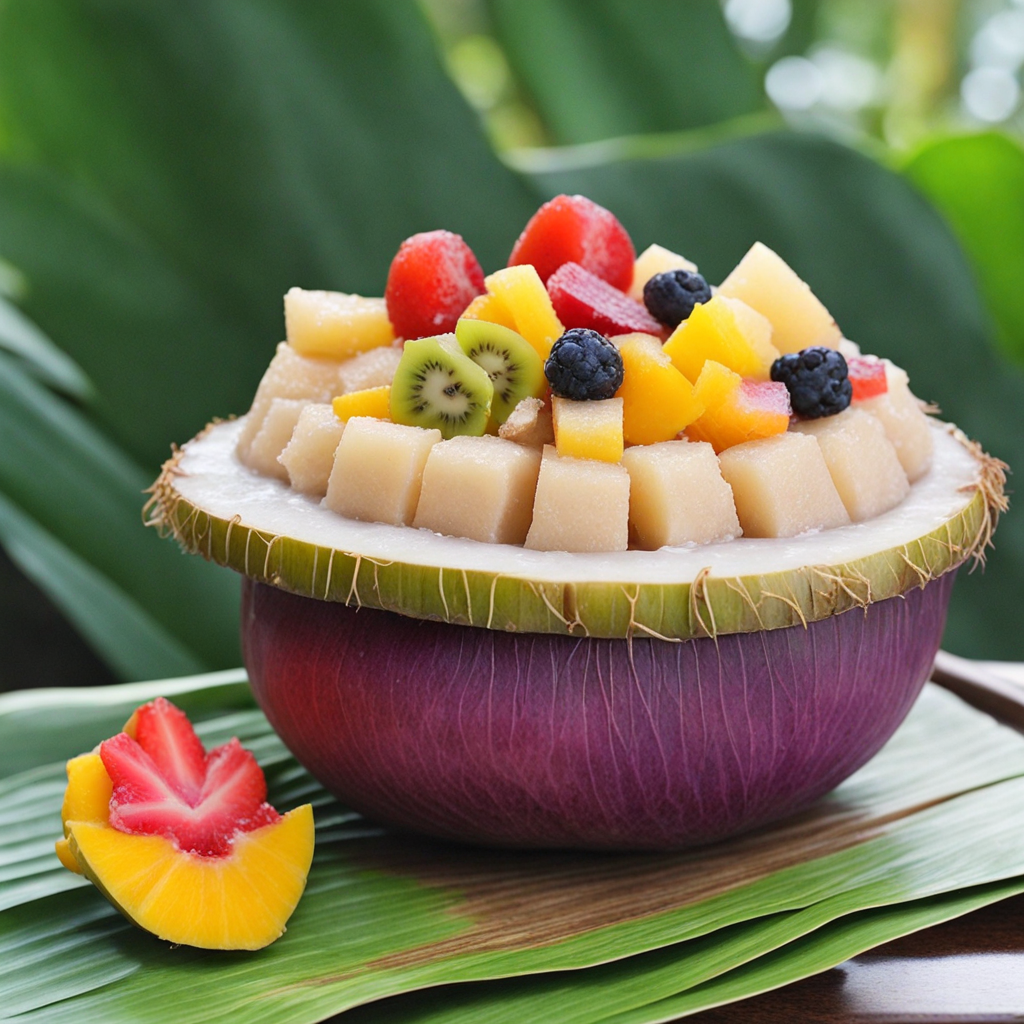Sweet Potato Pudding
Sweet Potato Pudding, a delightful dessert from the small island nation of Tuvalu, offers a unique combination of flavors and textures that is both comforting and satisfying. The pudding is crafted primarily from locally grown sweet potatoes, which are naturally sweet and creamy when cooked. The vibrant orange hue of the sweet potatoes gives the dish an appealing appearance, while their subtle earthiness shines through, creating a rich base that is both nutritious and delicious. This pudding is often enriched with coconut milk, adding a luscious creaminess that complements the sweet potatoes beautifully, making each bite a tropical experience. To enhance the flavor profile, traditional recipes may include a hint of vanilla or a sprinkle of nutmeg, elevating the taste to new heights. The sweet potato pudding is typically steamed or baked until it becomes firm yet tender, making it easy to slice and serve. As it cools, the pudding develops a slightly chewy texture, while the sweetness intensifies, resulting in a dessert that is both indulgent and wholesome. Often enjoyed warm or at room temperature, it is not uncommon to find it served alongside fresh fruit or drizzled with additional coconut cream for an extra layer of flavor. Sweet Potato Pudding is not just a treat; it embodies the essence of Tuvalu’s culinary traditions, showcasing the importance of utilizing local ingredients. This dish is often prepared for special occasions and family gatherings, symbolizing warmth and hospitality. Each bite transports you to the serene shores of Tuvalu, where the sweetness of the pudding mirrors the warmth of the island’s culture and people. For those seeking to explore new culinary horizons, Sweet Potato Pudding promises a delightful journey into the heart of Tuvaluan cuisine, leaving a lasting impression on the palate.
How It Became This Dish
The History of Pudinga Kape: A Culinary Gem of Tuvalu Origins and Ingredients Pudinga Kape, a traditional dessert from Tuvalu, is a delightful pudding that exemplifies the rich culinary heritage of this Pacific island nation. Its name translates to "taro pudding," reflecting its primary ingredient: kape, or taro root. Taro itself is a staple in Tuvaluan agriculture and cuisine, cultivated for centuries in the fertile volcanic soils of the region. The origins of Pudinga Kape can be traced back to the pre-colonial era, when the people of Tuvalu relied on locally sourced ingredients for sustenance. The pudding is made using a combination of grated taro, coconut milk, sugar, and sometimes a hint of vanilla or pandan for flavoring. The simplicity of the ingredients showcases the Tuvaluan philosophy of using fresh, natural produce that is available in abundance on the islands. Taro, rich in carbohydrates and nutrients, has been a vital food source for countless generations, serving not only as a dietary staple but also as a symbol of cultural identity. Cultural Significance In Tuvalu, Pudinga Kape is more than just a dessert; it is a dish that embodies the spirit of community and tradition. Food in Tuvaluan culture plays a central role in social gatherings, celebrations, and rituals. Pudinga Kape is often prepared for special occasions, including weddings, birthdays, and national holidays, where it is enjoyed by families and friends. The act of making this pudding is usually a communal effort, with family members coming together to grate the taro, mix the ingredients, and steam the pudding in traditional banana leaves. The pudding's preparation and consumption are steeped in rituals that reflect Tuvalu's deep respect for nature and the resources it provides. The process of harvesting taro, selecting the best coconuts, and preparing the pudding is often accompanied by stories and songs that celebrate Tuvaluan history and identity. This connection to the land and the community enhances the pudding’s cultural significance, making it a cherished part of Tuvaluan heritage. Development Over Time As Tuvalu has faced various challenges over the years, including climate change and globalization, the culinary landscape, including the preparation of Pudinga Kape, has undergone subtle transformations. Traditionally, Pudinga Kape was steamed in a traditional earthen oven, known as a "umu," which imparted a unique flavor and texture to the pudding. However, with the advent of modern cooking techniques and appliances, many households have adapted to using electric steamers or ovens. This shift reflects the broader changes in Tuvaluan society, where traditional practices coexist with modern influences. The introduction of imported ingredients has also impacted the way Pudinga Kape is prepared. While the core components remain the same, some families experiment with different flavors and textures, incorporating ingredients like chocolate or fruit purees to appeal to younger generations. This adaptability is a testament to the resilience of Tuvaluan culture, which has managed to preserve its culinary roots while embracing new influences. Moreover, the global interest in traditional foods has led to a resurgence in the popularity of Pudinga Kape beyond Tuvalu's shores. As tourists flock to the islands, they are often eager to experience authentic local cuisine, and Pudinga Kape has emerged as a must-try dish. Local chefs and home cooks are increasingly taking pride in their culinary heritage, showcasing Pudinga Kape at cultural festivals and food events, both locally and internationally. This not only elevates the status of Pudinga Kape but also serves as a means of cultural exchange, allowing others to appreciate the unique flavors and traditions of Tuvalu. Nutritional Aspects and Sustainability In addition to its cultural significance, Pudinga Kape is also notable for its nutritional benefits. Taro is a low-fat, high-fiber food that provides essential vitamins and minerals, making Pudinga Kape a relatively healthy dessert option. The use of coconut milk adds a rich creaminess to the pudding while also supplying healthy fats. As awareness of health and nutrition grows, there is potential for Pudinga Kape to be embraced by health-conscious individuals who seek out wholesome and traditional foods. Sustainability is another important aspect of Pudinga Kape. The reliance on local ingredients means that the dish is inherently aligned with sustainable practices. Taro is a resilient crop that thrives in Tuvalu's climate, and its cultivation does not require extensive resources. By prioritizing locally sourced foods like taro and coconut, Tuvaluans can reduce their carbon footprint while preserving their culinary traditions. Culinary Legacy and Future Prospects As we look to the future, the legacy of Pudinga Kape is likely to continue evolving while retaining its cultural significance. The ongoing efforts to preserve traditional food practices, coupled with the influence of globalization, will shape the way Pudinga Kape is enjoyed by future generations. With an increasing focus on cultural tourism, Pudinga Kape may become a symbol of Tuvaluan identity on the world stage, representing a blend of tradition and innovation. Educational initiatives aimed at teaching younger generations about their culinary heritage will also play a crucial role in this evolution. By instilling a sense of pride in their traditional food, Tuvaluans can ensure that Pudinga Kape remains a beloved dish for years to come. Whether served at festive gatherings or enjoyed in the comfort of home, Pudinga Kape will undoubtedly continue to be a cherished aspect of Tuvaluan culture, bridging the gap between past and present. In conclusion, Pudinga Kape is more than just a pudding; it is a testament to the rich history, cultural significance, and resilience of the Tuvaluan people. From its humble beginnings rooted in local agriculture to its modern adaptations, Pudinga Kape represents a culinary journey that reflects the heart and soul of Tuvalu. As this beloved dessert continues to evolve, it will undoubtedly remain a cherished symbol of identity, community, and tradition for generations to come.
You may like
Discover local flavors from Tuvalu


